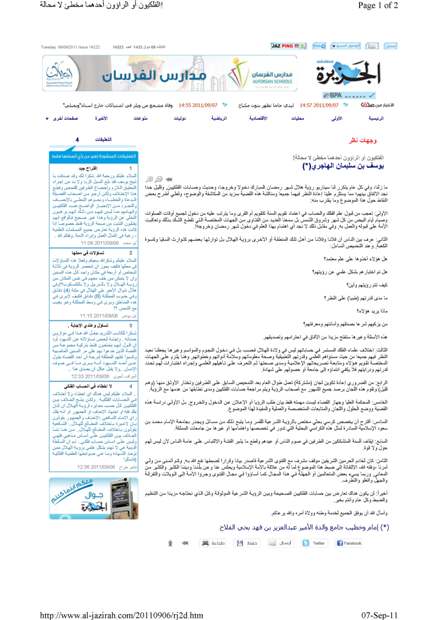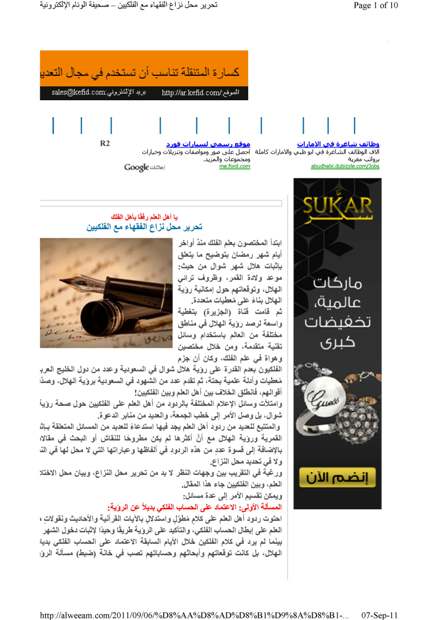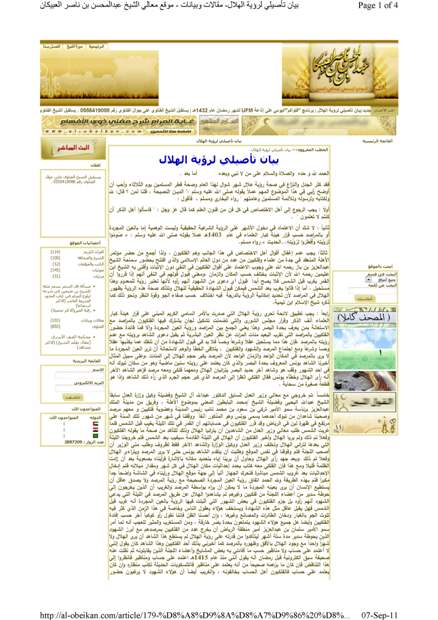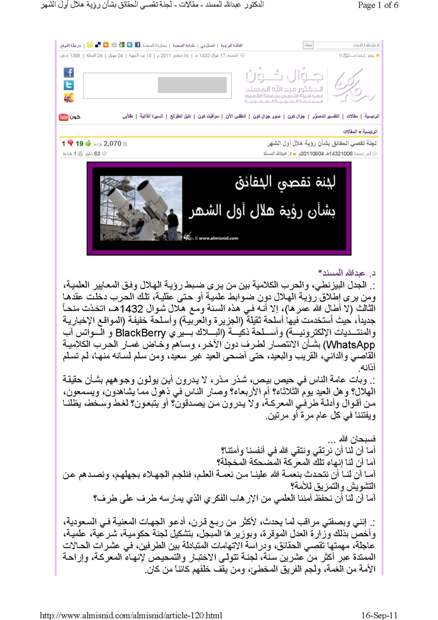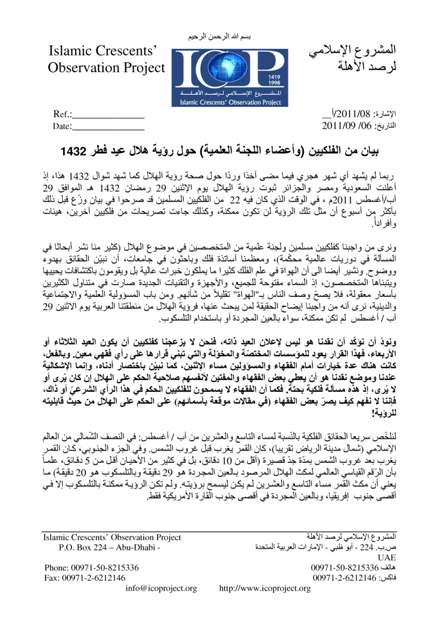Visibility of Shawwal Crescent 1432 AH
- When to Observe Shawwal Waxing (NEW) Crescent ?
- Shawwal Waxing (NEW) Crescent Observation Results
- The OFFICIAL First Day in Different Countries
- When to Observe Ramadan Waning (OLD) Crescent ?
- Ramadan Waning (OLD) Crescent Observation Results
- Videos and Articles Confirming the Impossibility of Sighting the Crescent on Monday from the Arabic World
When to Observe Shawwal Waxing (NEW) Crescent ?
The geocentric conjunction (Geocentric New Moon) will occur Inshalla on (Monday 29 August 2011) at 03:04 UT.
Sighting the new crescent on (Monday 29 August 2011) and (Tuesday 30 August 2011) is shown in the below graphs using the program Accurate Times by Mohammad Odeh according to Odeh criterion. Where:-
- It is impossible to see the crescent from the areas located under the red color. Because either the Moon on this day sets before the Sunset and/or the topocentric conjunction occurs after the Sunset.
- The crescent is expected to be seen by optical aid only from the areas located under the blue color.
- The crescent is expected to be seen by optical aid from the areas located under the magenta color. In these areas the crescent could be seen by naked eye if the atmospheric conditions are superb and the observer is experienced.
- The crescent is expected to be easily visible by naked eye from the areas located under the green color.
- The crescent cannot be seen from uncolored areas, even though the Moon sets in these locations after the Sunset and the topocentric conjunction occurs before the Sunset, but the Moon is not sufficiently illuminated in order to be seen as crescent even by optical aid.
- Kindly notice that the below graph shows the possibility of seeing the crescent from areas between 60 degrees north of Equator down to 60 degrees south of Equator.

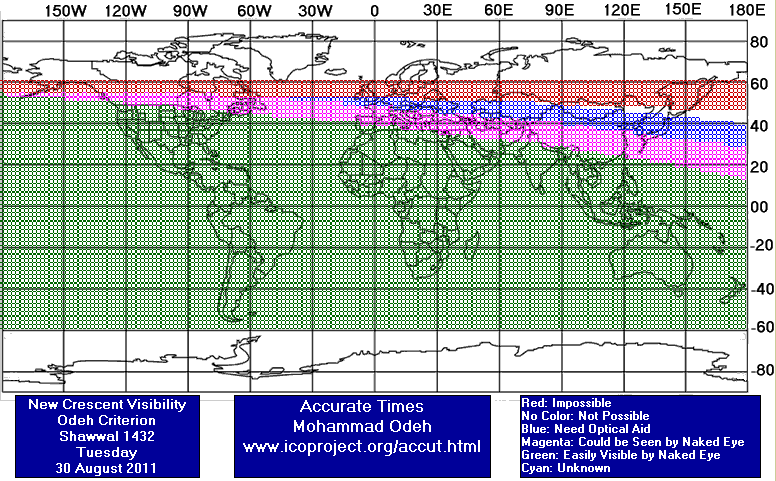
According to the Universal Hejric Calendar (UHC), which is based on the calculated crescent visibility, the start of this month in the Eastern Region will be on Tuesday 30 August 2011 and in the Western Region will be on Tuesday 30 August 2011. Kindly notice that the UHC is a pre-calculated calendar, which adopts a certain criterion to start the new Hejric month. Your country/organization might adopt different criterion to start the new Hejric month. So it is highly advised to read the UHC website before giving any judgment.
- Results of seeing the crescent, and the first day of the month in different countries will be added here Inshalla as we receive the reports from ICOP's members. If you wish to be a member in ICOP, or to know more about it, kindly click here.
Shawwal Waxing (NEW) Crescent Observation Results
Mon 29 August 2011
Algeria
Mr. Hocine Chikh Aissa said: "The new crescent of shawwal 1432 was not seen ,The western horizon was partly cloudy and hazy. The Sun set Behind clouds at 19:10.the moon set in the same time at the sun, Takabal Allah EL siam wa EL kiam Aid mubarek for all Muslimen." "
Mr. Omar Tadjrouna said: "place of observation: the hill of "Bou Nouar""
Germany
Eng. Martin Elsaesser said: "The young crescent could easily be imaged this morning around 10:30 (UT+2) (in daytime), at an elongation of 6.6°, using the established CCD system. Sky conditions were OK, but Cirrus-clouds and contrails were distracting. No chance to observe it here after sunset, as the moon sets 18 minutes before sunset. Even tomorrow the lag-time will be only 10 minutes. ملاحظة من الإدارة: لم ير الهلال بالعين المجردة ولا باستخدام التلسكوب. إنما تمت رؤية الهلال نهارا قبل غروب الشمس عن طريق تقنية التصوير الفلكي المتقدمة."
Nigeria
Mr. Simwal Jibril said: "The western horizon was very cloudy even sunset was not visible."
Qatar
Saudi Arabia
Eng. Qamar Uddin said: "Abdul Aziz Raje of Wifaqul Ulama UK was visiting Saudi Arabia for Umarah. He has reported joining the official Madinah Hilal Committee with 15 others from the UK, including many scholars. The sky condition was absolutely clear, but none of the group members were able to sight the Hilal. None of the other official Hilal Committee astronomers were able to sight the Hilal either, even with their telescopes. However, a few individuals from Riyadh have claimed sighting and the Supreme Court has accepted their claims. May Allah forgive us all for our mistakes and wish you all a happy Eid!"
Mr. Abdul-Rasaq Abdul-Azeez Ishola said: "Asalam aleikun I and Dr. SAheed of Jizan with Dr Muhammed from Maiduguri went to search for the moon but it was not seen but claimed seen in Riyad Happy Eid to u all"
South Africa
Dr. Abdurrazak Ebrahim said: "Some 15 000 to 20 000 Muslims were gathered at Three Anchor Bay, Cape Town, this evening. A mass Maghrib Salaah followed by people laying out blankets on the lawns adjoining the Atlantic Ocean and partaking in their meals. An inspiration sight and a fantastic experience. Wish all of you were here."
Trinidad and Tobago
Mr. Abdurrahman Ali said: "The crescent was not seen in Trinidad and Tobago, Grenada, Barbados and Guyana. We will complete thirty days and the Eid will be celebrated on Wednesday 31st August 2011, Insha Allah."
United Kingdom
Eng. Qamar Uddin said: "On Monday 29 August 2011 (29 Ramadan 1432 AH) many people from throughout UK have attempted to sight the crescent moon (Hilal) of Shawwal after sunset. None of the groups were able to sight the Hilal, as most places were cloudy. Many thanks to all those who have sent their reports. We have not received any verified/confirmed sighting reports from any countries east of UK/Morocco either. There was a slight possibility of sighting in South Africa but the United Ulama Board of South Africa have declared negative sighting (see attached announcement). Therefore, the Wifaq/Batley Ulama have decided that the month of Ramadan 1432 AH will complete 30 days and Eid ul Fitr/1 Shawwal 1432 AH will be on Wednesday 31 August 2011, Insha-Allah. Eid Mubarak to all Muslims in the world. The York group of observers included Maulana Hasib Mayet, Maulana Imran Lunat, Vasiullah Bodiyat and Yahya Tai from Batley, plus Qamar Uddin."
United States
Dr. Javad Torabinejad said: "I arrived at my sighting location about 7:30 pm EDT (sunset: 7:55; apparent 7:50) and started scanning the expected area for the crescent, using a couple of pairs of binoculars (10X50 and 7X50). I stayed there till 7:55 pm (moonset: 7:59 pm)."
Tue 30 August 2011
Algeria
Mr. Omar Tadjrouna said: "place of observation: the hill of "Bou Nouar""
Australia
Mr. Afroz Ali said: "The crescent was sighted in multiple locations."
Bangladesh
Mr. ABM Ruhul Hassan said: "The sky was clear in almost all parts of the country.The crescent was sighted just after the sunset coxsbazar ( sea shore area)"
Brunei Darussalam
Mr. Hazarry Haji Ali Ahmad said: "The astronomical society of Brunei Darussalam carried out the moon crescent observation at Agok Hill. The weather was couldy and the moon crescent was observed only for a few minutes at 18:55 local time, about 25 minutes after local sunset. Assigned at vantage points throughout the country could sight the new moon of Syawal 1432. The official announcement of the sighting was also made on Tv and Radio."
Ghana
Mr. Abdul-Aziz Anyang said: "Mallam Yusif of Odoomser which is about 50 km from the Greater Accra region saw the new crescent for Shawaal with some of the community leaders. He personally called me to tell me of the sighting, but a report from the Ashanti region, Kumasi said that the new crescent was sorely seen at 1800 hrs (Monday August 29. Some muslims in the Greater Accra region also said that the Kingdom of Saudi Arabia has sighted the new crecent in the Kingdom, hence Tuesday August 30 will be the Eid and indeed, some performed Eid prayers today. Officially Ghana is celebrating the Eid on Wednesday, August 31, 2011."
Indonesia
Mr. AR Sugeng Riyadi said: "The New Cerscent of Syawwal 1432 AH was SEEN from Surakarta Indonesia, on Tuesday 30 August 2011."
Iran
Pakistan
Mr. Alam Sultan said: "Today (Tuesday 30th August 2011), our some observers sighted the moon and central official moon sighting committee of Pakistan also received many positive reports hence it has been announced officially that Wednesday 31st August 2011 is 1st Shawwal (Eid-ul-fitr) 1432 in Pakistan. Nearly whole Pakistan was cloudy or hazy. May Allah accept our good deeds and bless us a happy Eid. "
Saudi Arabia
United Arab Emirates
United States
Eng. Mohammad Rahman said: "I saw the crescent moon today evening with bare eyes on 30 August 2011. Our Eid ul Fitr will be celebrated on 31 August, Wednesday in Houston city of Texas. Eid Mubarak to all."
Dr. Javad Torabinejad said: "My first binocular (7X50) sighting was at 3:57 pm EDT followed by naked eye sighting. The horns were at 12:30 and 5:00 O'clock (12:30;2:30;5:00). The sky was partly cloudy and hazy. Later in the evening, the crescent was spotted at 8:26 pm in a hazy and partly cloudy western horizon (sunset: 7:53 pm EDT; apparent sunset: 7:49 pm). I arrived at my sighting location at 7:32 pm and using the pair of binoculars started scanning the expected location in the clearings. The first sighting was at 8:16 pm when the crescent appeared in an opening; at this time the crescent was about 2-3 degrees above horizon. It soon disappeared behind the clouds only to reappear again and set around 8:27 pm (actual moonset: 8:33 pm EDT)"
The OFFICIAL First Day in Different Countries
Tue 30 August 2011
1 . Algeria
2 . Bahrain
3 . Egypt
4 . Iraq
5 . Jordan
6 . Kuwait
7 . Lebanon
8 . Malaysia
9 . Mauritania
10 . Nigeria
11 . Palestine
12 . Qatar
13 . Saudi Arabia
14 . Sudan
15 . Syria
16 . Tunisia
17 . Turkey
18 . United Arab Emirates
19 . Yemen
Wed 31 August 2011
1 . Australia
2 . Bangladesh
3 . Brunei Darussalam
4 . Ghana
5 . Indonesia
6 . Iran
7 . Libya
8 . Morocco
9 . Oman
10 . Pakistan
11 . South Africa
12 . Trinidad and Tobago
13 . United Kingdom
14 . United States
When to Observe Ramadan Waning (OLD) Crescent ?
The geocentric conjunction (Geocentric New Moon) will occur Inshalla on (Monday 29 August 2011) at 03:04 UT.
Sighting the OLD crescent on (Monday 29 August 2011) and on (Sunday 28 August 2011) is shown in the below graphs using the program Accurate Times by Mohammad Odeh according to Odeh criterion. Where:-
- It is impossible to see the OLD crescent from the areas located under the red color. Because either the Moon on this day rises after the Sunrise and/or the topocentric conjunction occurs before the Sunrise.
- The crescent is expected to be seen by optical aid only from the areas located under the blue color.
- The crescent is expected to be seen by optical aid from the areas located under the magenta color.. In these areas the crescent could be seen by naked eye if the atmospheric conditions are superb and the observer is experienced.
- The crescent is expected to be easily visible by naked eye from the areas located under the green color.
- The crescent cannot be seen from uncolored areas, even though the Moon rises in these locations before the Sunrise and the topocentric conjunction occurs after the Sunrise, but the Moon is not sufficiently illuminated in order to be seen as crescent even by optical aid.
- Kindly notice that the below graph shows the possibility of seeing the crescent from areas between 60 degrees north of Equator down to 60 degrees south of Equator.

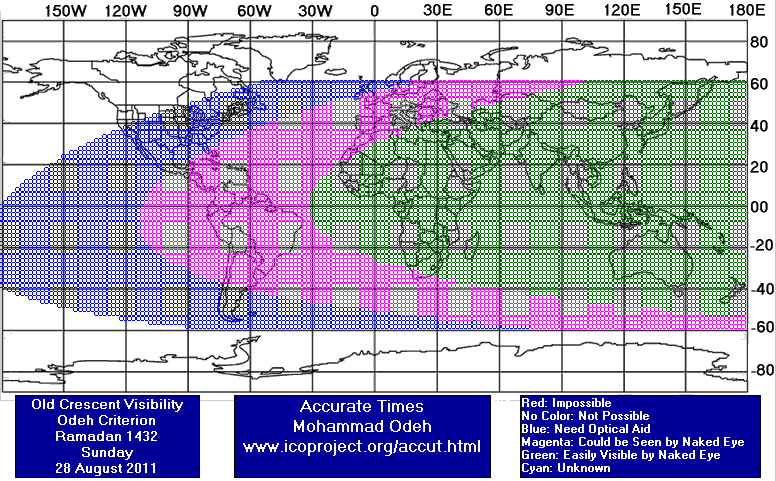
Ramadan Waning (OLD) Crescent Observation Results
Sun 28 August 2011
Germany
Eng. Martin Elsaesser said: "The old crescent on 28. August could easily be seen with small binoculars, but naked eye sighting was unsure. The sky conditions were quite good, after a cold front had cleaned the air and cooled the temperature to 8°C. While still low on the horizon, the crescent arc appeared quite distorted."
Ghana
Mr. Abdul-Aziz Anyang said: "All the ten regional capital was misty and cloudy with small pockets of rainfall so waning crescent was not seen."
Iraq
Dr. AbdulSattar M. Khidhir said: "The old crescent was seen by my group (4 persons including me)> The crescent was seen when it elevation becomes > 1 degree. It stays visible between 15-20 minutes. "
Videos and Articles Confirming the Impossibility of Sighting the Crescent on Monday from the Arabic World
Dr. Al-Sadeq Al-Gheryani / President of Libyan Higher Ifta' Council, clarifying the the Libyan decision to have Eid on Wednesday, and emphasizing on the impossibility of sighting the crescent on Monday.
The Islamic Crescents Observation Project (ICOP) coverage on Aljazeera Mubasher channel on 29 Ramadan. The participants were: Prof. Nidhal Guessoum (Astronomy Professor in the American University in Sharjah), Dr. Hayman Metwally (Astronomy Professor in Cairo University), Mohammad Odeh (ICOP Chairman) and Prof. Ali Al-Qorradaghi (Professor and Head of Fiqh Department in Qatar University and the Secretary General of the International Union for Muslim Scholars). All confirming the impossibility of seeing the crescent on Monday.
"Daleel" Channel Interview about the Wrong Shawwal Sighting
ICOP Statement about Sighting the Crescent on Monday. 
Prof. Hassan Basurrah Statement / Head of Astronomy Department in King Abdulaziz University in Jeddah 
Prof. Hatem Odah Statement / Head of the National Research Institute of Astronomy & Geophysics (NRIAG) in Egypt 
Dr. Ali Mohammad Al-Shukri Statement / Professor in Physics Department , King Fahd University of Petroleum and Minerals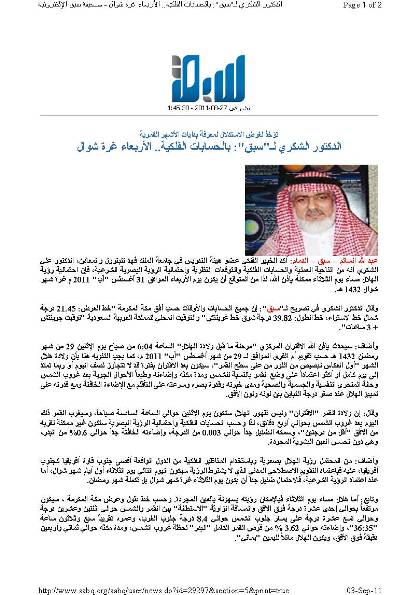
Dr. Khaled Al-Zaag Statement / Head of Buraida Observatory in Saudi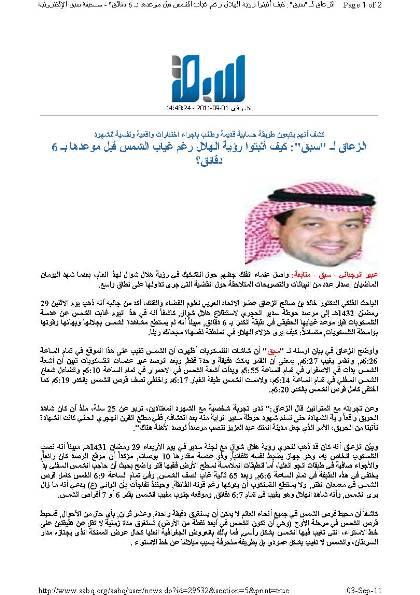
Prof. Sharaf Al-Qodah / Previous Head of Sharia Department in University of Jordan: "We Broke Our Fast Wrong, and We Have to Compensate"
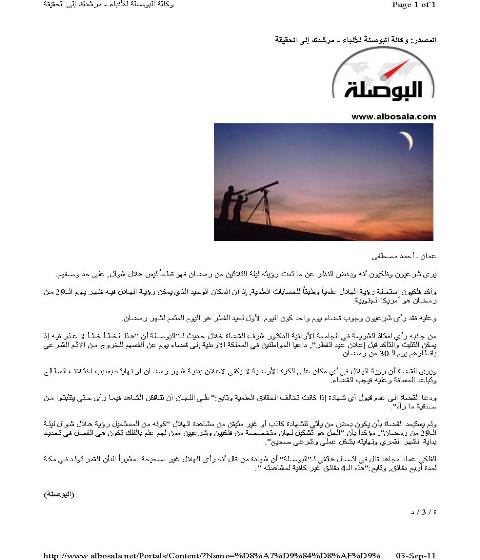
Artcile by Dr. Hamza Al-Mozainy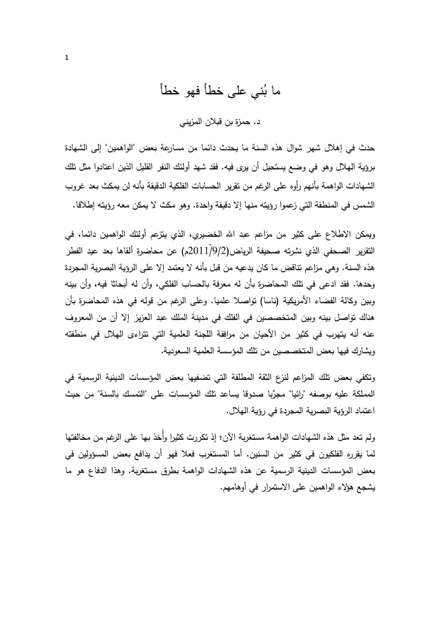
Article by Dr. Saleh Al-Hathlol 
